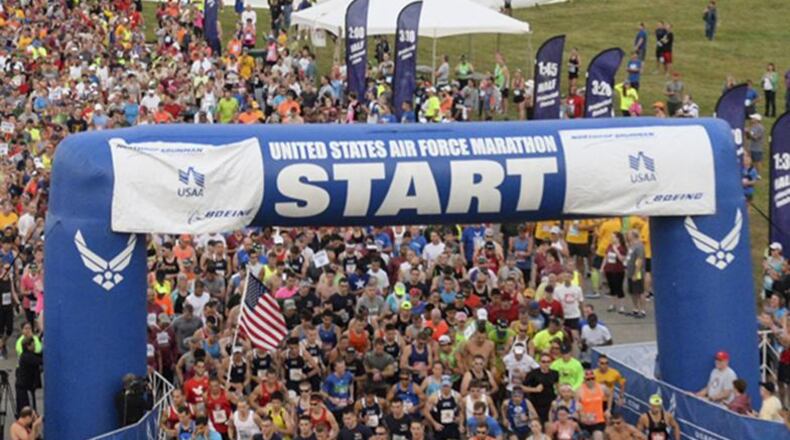Even though 3,000 registered runners deferred -- meaning, they are slotted in to run next year’s race without paying new registration fees -- this year’s event grew its numbers.
“We actually did about 1,500 more registrations this year than last year,” Marathon Director Brandon Hough said. “So we grew. We got so many new runners into the frame.”
The COVID-19 pandemic has forced the team behind the marathon and its array of events to adapt, along with everyone else. Hough thinks they nevertheless created an event to remember.
This year’s race will be “virtual.” Runners will run on their own time and upload their results. (Instructions can be found at https://www.usafmarathon.com/)
But in a sense, that’s nothing new. The marathon had a virtual component for runners who could not make it to the starting line well before the pandemic.
“I would definitely expect to see more of this in 2021 and beyond,” Hough said. “It’s here to stay.”
What follows is an edited transcript of a recent interview with Hough.
Dayton Daily News: How is this year’s race different?
Hough: “I just got asked by a friend in a parking lot at Lowe’s on Sunday, ‘Well, what does a virtual race mean?’ And I go: ‘Well, the difference is: Historically, the race is very regimented. You have to run on Sept. 19. You have to show up at a certain time. The gun goes off at a specific time. Everything is very regimented.'
“There are benefits to that. Obviously, we have the flyover, the fireworks, a certain experience we can offer people.
“But in a virtual race, the benefit is, it’s completely on your time. So we’re telling people, you have the entire month of September to run your selected distance.
“And the best part about this is, I’ve done a few virtual races this summer, and I always look for a day on the calendar when the weather is going to be good.”
Question: Isn’t that a double-edged sword, though? The Air Force Marathon is all about the experience.
Hough: “That’s always been the downside. I spent the whole past year arranging an HH-60 (helicopter) to fly over the start line, and the fireworks take off, and the runners take off, and we can’t offer that. And I’ve told people, ‘I can’t get an HH-60 to fly over your house now.'
“But the big upside to us is that virtual event is so accessible to people.”
Question: It sounds likes this has worked elsewhere, hasn’t it?
Hough: “The spring races were put in a really tough position. They had the rug pulled out from under them, days before their race. That was tough for them. They didn’t have the experience that we’re going to have, because we have foresight here. We were able to cancel out a couple of months with advance notice, knowing the (COVID) situation didn’t seem to be improving.
“So we’re actually kind of leading the way here. We’re not leading the way in the sense that there have been plenty of other virtual races. Virtual racing isn’t even new. It’s been around probably for the better part of eight to 10 years.
“It’s becoming mainstream. And it’s really becoming mainstream now, because of the pandemic.”
Question: What else is different about this year’s race?
Hough: “For the first time in our history, we went away from having medals that were made overseas to having domestically sourced medals, made-in-America medals, with American steel. I think that was a very popular move. It looks a little different. But I think our runners were very happy with that change.
About the Author



